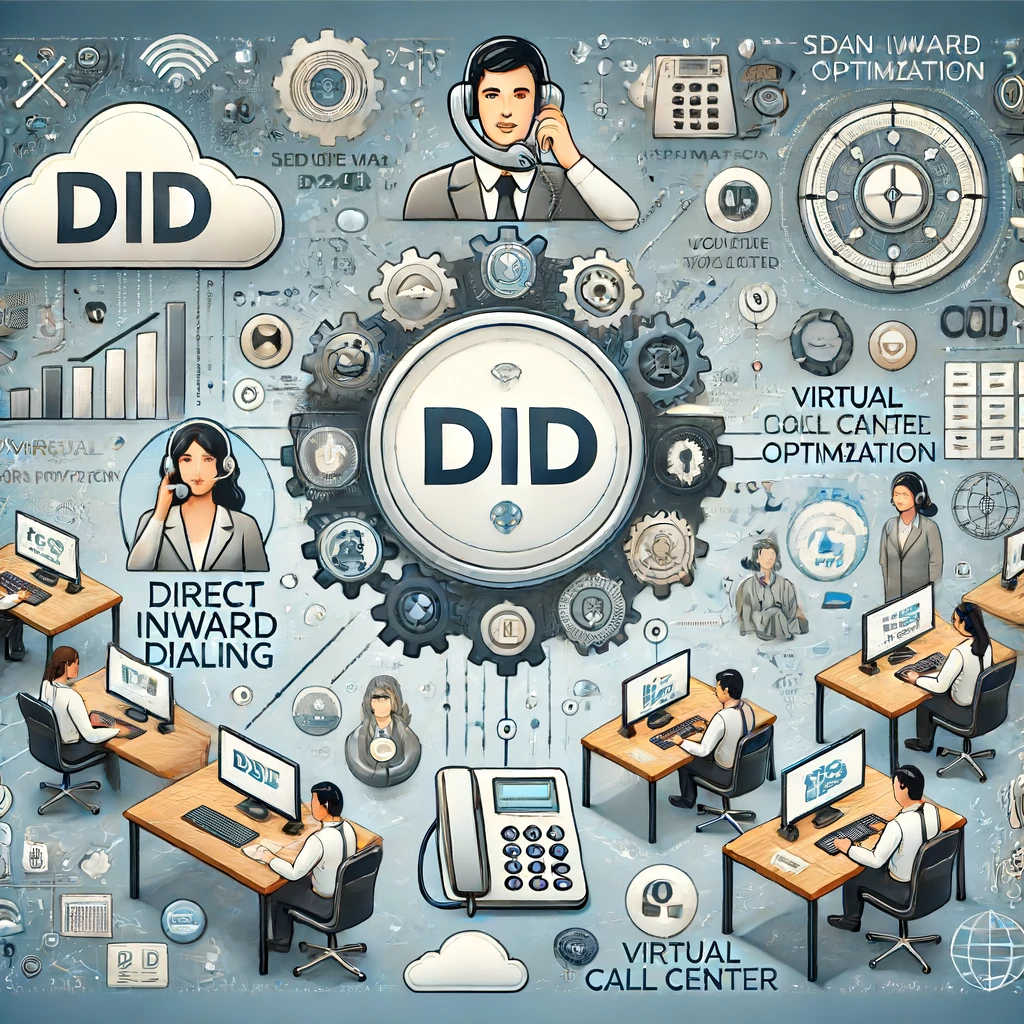The Role of DID in Emerging Telecom Technologies
Key Takeaways
-Role of Direct Inward Dialing (DID) facilitates is for call management and routing in telecom systems.
WebRTC DID: Enables browser-based communications using DID numbers.
Cloud Communications: DID numbers enhance cloud telephony by providing virtual numbers.
Unified Communications (UC): DID supports seamless integration of voice, video, and messaging services.
Communications Platform as a Service (CPaaS): Provides APIs for DID functionalities, enhancing communication solutions.
Voice over LTE (VoLTE) and 5G Voice Services: DID ensures smooth transition and connectivity in advanced networks.
SD-WAN Voice: DID numbers optimize voice traffic over software-defined networks.
Virtual Call Centers: DID supports remote and flexible call center operations.
Remote Work Solutions: DID enables robust telecommuting capabilities with dedicated business numbers.
Internet of Things (IoT) Connectivity: DID numbers facilitate M2M communications in IoT ecosystems.
Smart Home/Office Systems: DID numbers enhance automation and communication in smart environments.
Number Masking/Privacy: DID ensures caller anonymity and privacy.
Call Tracking Analytics: DID numbers provide detailed call tracking and analytics.
Geo-routing Capabilities: DID numbers enable geographic call routing for improved customer experience.
Telecom as a Service (TaaS): DID integrates with TaaS for scalable communication solutions.
Voice/Messaging APIs: DID functionalities are available through APIs for custom communication solutions.
DID Marketplaces/Platforms: Offer a range of DID services and features for businesses.
Hybrid Cloud Telephony: DID supports hybrid models combining on-premises and cloud solutions.
BYOC (Bring Your Own Carrier): DID enables integration with existing carrier services.
DID Federation and Interoperability: Ensures compatibility and integration across different telecom systems.
DID Integration in Emerging Telecom Technologies
DID integration plays a crucial role in modern telecom systems. By providing unique phone numbers, businesses can manage multiple lines without physical phones. This feature enhances flexibility and scalability in communication systems.
WebRTC DID: WebRTC allows real-time communication directly from web browsers. Integrating DID with WebRTC ensures seamless call routing and management.
Cloud Communications: DID enhances cloud telephony by assigning virtual numbers to users. This approach reduces infrastructure costs and increases operational efficiency.

Enhancing Unified Communications (UC) with DID
Unified Communications (UC) platforms benefit significantly from DID integration. DID supports various communication channels, including voice, video, and messaging, ensuring a cohesive user experience.
Communications Platform as a Service (CPaaS): CPaaS providers offer APIs that integrate DID functionalities. This allows businesses to customize their communication solutions effectively.
Voice over LTE (VoLTE) and 5G Voice Services: DID ensures compatibility and seamless transition in advanced network environments.
Feature | Benefit |
UC Integration | Cohesive communication experience |
CPaaS with DID | Customizable communication solutions |
VoLTE and 5G Voice Services | Smooth transition and connectivity |

DID for Remote Work and Virtual Call Centers
The rise of remote work and virtual call centers has been significantly facilitated by DID numbers. Furthermore, DID enables businesses to assign unique numbers to remote employees, thus ensuring seamless communication and professional interactions. Consequently, this advancement supports better management and coordination of remote teams.
SD-WAN Voice: DID optimizes voice traffic over software-defined networks, enhancing call quality and reliability.
Remote Work Solutions: Dedicated business numbers provided by DID enable robust telecommuting capabilities.
Feature | Benefit |
Virtual Call Centers | Flexible and scalable operations |
SD-WAN Voice | Enhanced call quality |
Remote Work Solutions | Dedicated business numbers |

Leveraging DID in IoT and Smart Systems
DID numbers are integral to the functionality of IoT and smart systems. Moreover, they facilitate machine-to-machine (M2M) communications, thereby enhancing automation in smart home and office environments. Consequently, these integrations ensure seamless and efficient operations. Additionally, DID numbers contribute to the overall improvement of smart system functionalities.
Internet of Things (IoT) Connectivity: DID numbers streamline M2M communications, ensuring efficient data exchange.
Smart Home/Office Systems: Automation and communication are improved with DID integration.
Feature | Benefit |
IoT Connectivity | Efficient M2M communications |
Smart Home/Office Systems | Enhanced automation and communication |

Conclusion: Role Of DID
- Direct Inward Dialing (DID) numbers are transforming the telecom landscape.
- Moreover, their integration across various technologies, from cloud communications to IoT, demonstrates their versatility and importance.
- Consequently, businesses leveraging DID can enhance their communication strategies.
- Additionally, they can improve operational efficiency and adapt to emerging trends.
- Therefore, the role of DID in enabling seamless communication and advanced functionalities cannot be overstated.
- Ultimately, this makes it a cornerstone of modern telecom solutions.
FAQ: Role Of DID
1. What is DID integration in telecom?
DID integration refers to the use of Direct Inward Dialing numbers in telecom systems to manage multiple lines without the need for physical phones. This enhances flexibility and scalability in communication systems.
2. How does DID enhance cloud communications?
DID enhances cloud communications by assigning virtual numbers to users, reducing infrastructure costs, and increasing operational efficiency.
3. What are the benefits of using DID in Unified Communications (UC)?
DID supports various communication channels, including voice, video, and messaging, ensuring a cohesive user experience. It also allows businesses to customize their communication solutions through CPaaS providers.
4. How does DID support remote work solutions?
DID enables businesses to assign unique numbers to remote employees, ensuring seamless communication and professional interactions. It also optimizes voice traffic over software-defined networks, enhancing call quality and reliability.
5. How is DID used in IoT and smart systems?
DID numbers facilitate machine-to-machine (M2M) communications and enhance automation in smart home and office environments, ensuring efficient data exchange and improved functionality
Additional Readings
SMS Wholesale Strategies
A2P SMS Wholesale Benefits
Power of SMS Global Communication
Automating Customer Engagement with SMS
Most Common SMS Fraud Types
Future VoIP SMS Predictions
SMS Job Market Trends
Innovations in SMS Technology Progressive Telecom LLC – Business Profile
Advanced Site Stats – Progressive Telecom